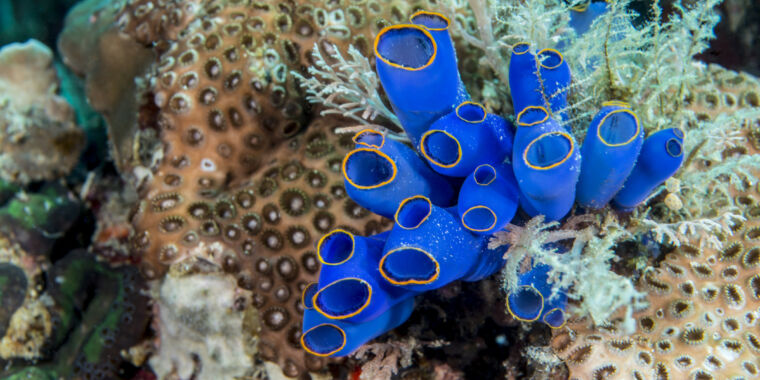
Beneath the waves, there are strange, almost alien creatures that raise questions about the evolution of life on Earth and our own earliest origins. The answers might be hiding in tunicates.
Tunicates are filter-feeding invertebrates that include sea squirts and salps. The more common ascidiacean species are sessile and attach to rocks or the seafloor, while the appendicularian species swim freely. Yet all of them spawn as larvae that vaguely resemble tadpoles. Motile tunicates tend to grow into something that looks like a larger version of the larva. The others eventually faceplant onto a surface and absorb their own tails while morphing into a sessile, tubelike form with two siphons.
Despite all this weirdness, there is now strong evidence that tunicates are the closest relatives to vertebrates, but a mystery still surrounds them. How did they evolve, and what did they evolve from? A 500 million-year-old fossil is now telling us more about the evolution of these peculiar life forms.
An evolutionary enigma
Discovered by evolutionary biologist Karma Nanglu of Harvard University, what is now known as Megasiphon thylakos has started to answer some unknowns about tunicates. Although they have been around since at least the Early Cambrian, tunicates have been mostly absent from the fossil record. The impeccably preserved M. thylakos specimen is finally giving more insight into their evolution and their relationship to vertebrates like humans.
“[The fossil] indicates divergence between [free swimming] appendicularians and all other tunicates occurred 50 million years earlier than currently estimated,” Nanglu and his research team said in a study recently published in Nature. “Ultimately, M. thylakos demonstrates that fundamental components of the modern tunicate body plan were already established shortly after the Cambrian Explosion.”
Because tunicates are nearly absent from the fossil record, it wasn’t known whether they started out as sessile organisms similar to ascidiaceans, or motile organisms like appendicularians. Unfortunately, the other existing tunicate fossil, Shankouclava anningense, is unclear. It does have some ascidiacean features but is missing other features that define ascidiaceans, such as the feeding siphons.
There are two hypotheses for the evolution of tunicates. The first suggests that their ancestral form was motile, like appendicularians, and that the sessile species evolved from motile ancestors. The second hypothesis argues that the genetics of modern tunicates make it unclear whether their ancestral form was motile or sessile.
New evidence from old rocks
Because of its observable characteristics, especially the tube structure and siphons that are so similar to modern ascidiaceans, the M. thylakos fossil could indicate that ancient tunicates began as sessile creatures.
What also stood out were the obvious dark bands running up and down its body. Nanglu and his team took hi-res images of the fossil and compared them to specimens of the extant tunicate Ciona intestinalis. It turned out that the bands appeared extremely similar to the muscles C. intestinalis uses to open and close its siphons when it feeds. The M. thylakos body plan that is now thought to have first emerged after the Cambrian Explosion, which may have been the largest burst of new organisms Earth has ever seen.
Where exactly the base of M. thylakos’ body attached to a rock or the seafloor is not visible because of deterioration. Despite that, its striking resemblance to extant ascidiacean tunicates like C. intestinalis has convinced Nanglu that early tunicates were most likely sessile, just like their descendants.
Unexpected relatives
So how could tunicates possibly be related to us? Like humans, tunicates belong to the phylum Chordata. Chordates share several common features, but the most notable is a flexible, supportive rod structure, or notochord, that runs down the animal’s length. There are only two chordate groups that are not vertebrates—tunicates and cephalochordates. Cephalochordates, like lancelets, used to be considered the closest living relative to vertebrates because they seemed more complex and morphologically similar. This was the assumption until a 2006 study found that tunicates are genetically closer to vertebrates than cephalochordates.
“Tunicates are an evolutionarily significant subphylum of marine chordates, with their phylogenetic position as the sister-group to Vertebrata, making them key to unraveling our own deep time origin,” Nanglu also said in the study.
Though tunicates are still keeping secrets, more fossils are possibly out there, just waiting to reach the surface of what was once a prehistoric ocean. They may have even more to say about where they—and we—came from.
Nature, 2023. DOI: 10.1038/s41467-023-39012-4 (About DOIs).
Elizabeth Rayne is a creature who writes. Her work has appeared on SYFY WIRE, Space.com, Live Science, Grunge, Den of Geek, and Forbidden Futures. When not writing, she is either shapeshifting, drawing, or cosplaying as a character nobody has ever heard of. Follow her on Twitter @quothravenrayne.

